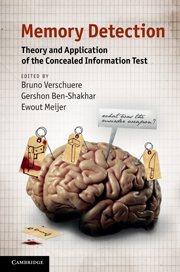Book contents
- Frontmatter
- Contents
- List of figures
- List of tables
- Notes on contributors
- Acknowledgments
- Part I Introduction
- Part II The laboratory: theoretical and empirical foundations of the Concealed Information Test
- 2 Detecting concealed information using autonomic measures
- 3 Detecting concealed information in less than a second: response latency-based measures
- 4 P300 in detecting concealed information
- 5 Detecting of deception and concealed information using neuroimaging techniques
- 6 New and old covert measures in the Concealed Information Test
- 7 Theory of the Concealed Information Test
- Part III Field applications of concealed information detection: promises and perils
- Part IV Conclusions
- Index
- References
5 - Detecting of deception and concealed information using neuroimaging techniques
Published online by Cambridge University Press: 05 June 2012
- Frontmatter
- Contents
- List of figures
- List of tables
- Notes on contributors
- Acknowledgments
- Part I Introduction
- Part II The laboratory: theoretical and empirical foundations of the Concealed Information Test
- 2 Detecting concealed information using autonomic measures
- 3 Detecting concealed information in less than a second: response latency-based measures
- 4 P300 in detecting concealed information
- 5 Detecting of deception and concealed information using neuroimaging techniques
- 6 New and old covert measures in the Concealed Information Test
- 7 Theory of the Concealed Information Test
- Part III Field applications of concealed information detection: promises and perils
- Part IV Conclusions
- Index
- References
Summary
Overview: In the last decade, neuroimaging techniques became increasingly popular to study the neural underpinnings of psychological processes and consequently these methods were also applied in deception research. After giving a brief overview on neuroimaging methods, this chapter summarizes studies using functional magnetic resonance imaging or positron emission tomography to examine the neural underpinnings of deception and information concealment. A meta-analysis was carried out to determine the clustering of brain activation peaks across studies when contrasting deceptive with truthful answers in the Differentiation of Deception (DoD) paradigm or critical details with neutral items in the Concealed Information Test (CIT). A ventral frontoparietal network that is involved in detecting behaviorally relevant stimuli by matching them with previously acquired memory representations was recruited in both experimental paradigms. On this basis, first attempts to derive individual diagnoses from neuroimaging data will be described and the application of the DoD paradigm to forensic questions will be critically discussed. With respect to the CIT, neuroimaging techniques can be highly useful to shed light on the neural processes underlying information concealment and this knowledge can ultimately help to improve CIT validity.
Introduction
Traditionally, autonomic measures have been used to detect deception and there is a long tradition of utilizing these recordings for detecting concealed information as well (Lykken, 1959, 1998). However, new techniques emerged in the last decades that allow for examining brain activity with high temporal (e.g., techniques relying on electroencephalography) or spatial resolution (e.g., functional magnetic resonance imaging [fMRI]).
- Type
- Chapter
- Information
- Memory DetectionTheory and Application of the Concealed Information Test, pp. 90 - 113Publisher: Cambridge University PressPrint publication year: 2011
References
- 29
- Cited by

